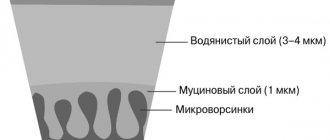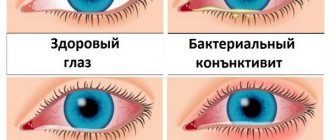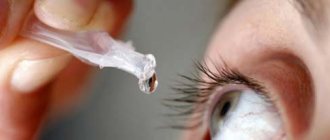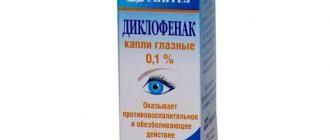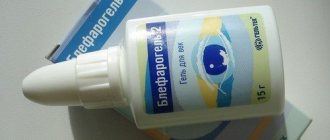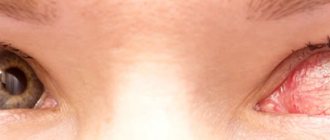How does the substance affect the organs of vision?
Hyaluronic acid, which is listed as sodium hyaluronate in the drops, has a regenerating effect on the epithelium. This substance is capable of attracting moisture and retaining it on the surface in large quantities.
Drops with hyaluronic acid perfectly moisturize and protect the surface of the eye from drying out, create a protective film on the surface of the cornea, relieve redness, irritation, fatigue, improve the condition of the fiber and normalize the activity of the sebaceous glands.
They promote the healing of microcracks and various damage on the surface of the eye, and increase the activity of other components of ophthalmic drugs.
Preparations with sodium hyaluronate reduce the risk of developing cataracts, relieve inflammation, normalize intraocular pressure and prevent optic nerve atrophy.
What else do you need to know about products with hyaluronic acid?
While patients are not yet very familiar with hyaluronic acid, its effect on the organs of vision, application features, and possible side effects. What you should remember if your doctor prescribed you drops from this category:
- hyaluronic acid is a completely safe substance that does not give any side effects if the patient does not have individual intolerance;
- all drops with hyaluronic acid have a viscous consistency, but when they come into contact with the surface of the cornea, they are easily distributed and form a stable film;
- with regular use, you can restore the organs of vision at the cellular level;
- drugs can be used for prophylactic purposes to prevent the formation of microcracks in the cornea;
- such medications cleanse the surface of the eye, moisturize it and soften it;
- recommended for regular use by those who constantly wear contact lenses;
- do not reduce the clarity of the visual image; on the contrary, they help restore vision in case of fatigue and some ophthalmological pathologies in the initial stages.
Like any other eye drops, these are also intended strictly for individual use. The bottle should not be shared with other patients. If after the end of the course of treatment not all drops have been used, they should be thrown away: an opened bottle cannot be stored for more than 30 days.
Pharmacies offer a fairly wide range of eye drops containing hyaluronic acid. It will not be difficult to choose the optimal product, taking into account the wide price range and availability of all products. Typically, these drugs are well tolerated and are available without a doctor's prescription. But it is better to undergo an examination by an ophthalmologist before starting a course of treatment in order to accurately determine all existing problems and ways to eliminate them.
Indications for use
Eye drops with hyaluronic acid are recommended for:
- dry eye syndrome;
- high risk of developing cataracts and glaucoma;
- long work in a smoke, dusty room;
- overwork and eye strain;
- dryness and irritation from wearing contact lenses;
- infectious and inflammatory eye diseases (various types of conjunctivitis).
It is also recommended to use such drops in the postoperative period after various eye surgeries to speed up healing.
Hyaluronic acid for eye restoration after surgery
It is known that surgical operations performed to eliminate visual defects and treat various pathologies have a long rehabilitation period, during which the visual activity of patients is significantly reduced. These procedures include:
- Cornea transplant (6–12 months recovery);
- Retinal augmentation (up to a year of medical supervision);
- Correction of strabismus (2–4 weeks of recovery);
- Laser vision correction (from 1.5 to 6 months of rehabilitation), etc.
To speed up the recovery period, special strengthening drugs are used, including hyaluronic acid . The role of this remedy in the healing of injuries to the visual system was studied[3] in 2021 by American scientists. The experiment involved laboratory mice with artificial damage to the cornea, which provoked severe inflammation. To eliminate it, rodents received hyaluronic acid daily with food. Comparison with the control group assessed the condition of the visual organs in the experimental subjects and the rate of tissue regeneration. It turned out that the resistance of the organs of vision to infections and mechanical damage is determined by the activity of epithelial stem cells. Hyaluronic acid stimulates the growth and reproduction of these structural units, allowing you to significantly speed up recovery after surgery.
“Hyaluronic acid can significantly shorten the recovery period after eye surgery”
Thus, the presence of hyaluronate in the tear fluid and eye tissue reduces the likelihood of developing pathologies of the visual system. When used by healthy people, this remedy eliminates visual fatigue and increases their resistance to prolonged stress. When used by patients with acute forms of diseases, hyaluronic acid enhances the effect of other ophthalmic drugs and improves the clinical picture of the disease. People who have undergone surgery will also appreciate the regenerative properties of this chemical compound.
Terms of use
Drops with hyaluronic acid can be prescribed for both treatment and prevention. Usually it is recommended to use the product 2-3 times a day, placing 1-2 drops in each eye, however, the treatment regimen may vary individually.
Order of using drops:
- wash your hands with soap;
- open the bottle with drops;
- take a comfortable position (sitting, standing or lying) and tilt your head back;
- pull back the conjunctival sac and drop drops into each eye, holding the bottle at a distance of 3-4 cm from the cornea.
Precautionary measures
Compliance with certain rules will avoid unpleasant consequences and increase the effectiveness of procedures. The use of one bottle by several patients at the same time is prohibited.
The drug is stored in a dark place, at a temperature that does not exceed 25 °C. You should pay attention to the expiration date of individual medications, which may not exceed 1 to 6 months after opening the bottle.
Drops with hyaluronic acid are sold from pharmacies without a prescription from an ophthalmologist. However, their use is recommended only after consulting a specialist.
List of the best drops
In pharmacies you can find drops to suit any budget, but you should purchase exactly those that your doctor prescribes. Most often, ophthalmologists prescribe one of the best drugs from the list.
Oksial
An Italian-made product containing sodium salt of hyaluronic acid and boric acid. Its cost is about 600 rubles.
The drops moisturize well, eliminate discomfort and maintain an optimal level of corneal hydration. They can be prescribed to adults and children at any age.
Hilo-Chest
A product from Germany, the main component of which is sodium hyaluronate. It is slightly cheaper than Oksial - 450 rubles.
The solution is often recommended for use by people who wear contact lenses. Hilo-chest combats the discomfort and irritation that may arise. The bottle of drops is equipped with valves and reservoirs partially coated with silver, which prevent the penetration of air and microbes into the solution.
Proactive
Drops from a domestic manufacturer contain not only hyaluronic acid, but also succinic acid. They enhance each other's actions, thereby achieving the best therapeutic effect.
Experts' opinion
According to experts, it is possible and necessary to use drops with hyaluronic acid according to indications. Nowadays, when visiting ophthalmologists, a diagnosis of dry eye syndrome is very often made, which cannot be ignored.
Constant drying of the conjunctiva leads to various diseases, contributes to decreased vision and causes discomfort. For some people this is a serious problem if their work involves a computer or small parts (for example, jewelers). Drops with hyaluronic acid allow you to maintain an optimal level of humidity, do not have a negative effect on the body and are not addictive.
Important! You can use ophthalmic drops with hyaluronic acid only after a doctor's prescription.
Useful video
Modern drops for the treatment of dry eyes sodium hyaluronate:
Hyaluronic acid: application in ophthalmology and treatment of dry eye syndrome
This review describes the use of GA in the anterior segment of the eye, in particular in the treatment of dry eye syndrome, as well as in contact lenses and lens care systems. Key words: hyaluronic acid, dry eye syndrome, contact lenses. Abstract Hyaluronic acid: it's usage in ophthalmology and in treatment of dry eye syndrome EA Egorov
RNIMU named after NI Pirogov Department of Ophthalmology named after acad. AP Nesterov This review describes the effectiveness of Hyaluronic acid in the treatment of dry eye syndrome and its usage in contact lens and solutions for contact lenses. Key words: hyaluronic acid, dry eye syndrome, contact lenses.
Hyaluronic acid (HA) is a natural polysaccharide with unique viscoelastic and hygroscopic properties. These characteristics determine the participation of HA in many processes in the human body [1–3]. HA is used in ophthalmological practice: in cataract surgery to optimize the installation of an intraocular lens, in vitreoretinal surgery. HA is included in the material of contact lenses to improve the comfort of wearing them [4]. Dry eye syndrome In recent decades, the importance of the problem of dry eye has increased. This is due to the intensive development of both modern ophthalmic surgery and pharmacotherapy of eye diseases. According to ARVO, in 2012, dry eye syndrome ranked third in the number of published studies, second only to glaucoma and age-related macular degeneration. According to Reddy, the prevalence of the disease reaches 11–17% among the entire population [17]. The quality of life of patients with moderate severity of dry eye syndrome is equal to that of patients with moderate angina pectoris [18]. The largest group is young patients (20–45 years old), in whom dry eye syndrome is associated with excessive evaporation of tear fluid (office syndrome, wearing contact lenses, refractive surgery, transient disorders of tear formation after infectious and inflammatory processes, etc. .) (Fig. 1). In the group of patients over 55 years of age, the disease is caused by endocrine changes leading to impaired tear formation and is called Sjögren's syndrome [19]. The result of tear replacement therapy should be the elimination of discomfort in patients. Drugs for the treatment of dry eye syndrome must have a physiological mechanism of action. These are the characteristics inherent in drugs based on HA. Method of production of HA for use in pharmacotherapy of dry eye syndrome The tolerability of HA-based tear substitutes is largely determined by the production method. Previously, methods were used to obtain HA from the vitreous humor of a cow's eye and the comb of a rooster. The disadvantages of these production methods were their high cost and the presence of protein impurities in the final product, which led to a large number of allergic reactions to the drug [5]. Modern HA production is based on a fermentation process using bacteria (Streptococcus equi and Streptococcus zooepidemicus). HA obtained in this way has a higher degree of purification, which explains the better tolerability of HA by patients [1, 2]. Properties of HA that determine its use for the treatment of dry eye syndrome HA is a natural polymer and belongs to the group of polysaccharides, which are also called connective tissue polysaccharides, mucopolysaccharides or glycosaminoglycans [1, 3, 7]. These polysaccharides influence the distribution of water in connective tissue, incl. and corneal stroma [6, 8]. According to its physicochemical properties, HA can change its structure depending on pH (acidity or alkalinity), salt concentration and the influence of pressure gradient [9]. An increase in the pressure and temperature gradient leads to a decrease in the viscosity of the solution. Similarly, due to the alkaline pH value, a more mobile molecular structure is formed [1, 10]. In addition to its viscoelastic properties, HA has a pronounced ability to retain water. This property may be due to the presence of a large number of hydroxyl groups, which leads to the formation of hydrogen bonds [1, 7, 11–14]. Researchers claim that HA can hold up to 1000 times its own weight in water [7, 24]. Normally in the human body, HA is found in the extracellular matrix of connective tissue in the skin and synovial fluid [1–3]. HA is also detected in the vitreous body, lacrimal gland, corneal epithelium and conjunctiva of the eye [1–3, 15, 16]. It is assumed that HA has anti-inflammatory properties and is involved in cell functioning processes, such as proliferation, differentiation and migration [20]. It has been proven that HA stimulates the migration of epithelial cells, which promotes the healing of corneal wounds [21–23]. Numerous studies have demonstrated the effectiveness of GCs in the symptomatic treatment of dry eye [3, 13, 25–29]. In this case, a balanced concentration of HA in the composition of the tear replacement drug is of great importance. In a controlled, double-blind, crossover study of 20 patients with severe dry eye, 0.1% HA, 0.2% HA, or placebo were administered 6 times daily for 14 days. The purpose of this study was not only to evaluate the effectiveness of GC in severe dry eye, but also to determine the most effective concentration of the drug. There were no significant differences between the 0.1% HA solution and placebo groups in Schirmer test results, tear breakup time (TBR), and rose bengal staining test results. However, when comparing a higher concentration of HA solution - 0.2% with placebo, a significant difference in the results of rose bengal staining was revealed in the group of patients receiving HA (P < 0.005). In this group, a more pronounced increase in VRSP was also observed compared with that with placebo (P < 0.005) [29]. In a comparative, randomized, blinded, placebo-controlled study of 12 patients, BPSP was assessed with 0.05%, 0.1%, or 0.3% HA solution. VRSP measurements were carried out before instillation of eye drops, as well as after 5, 15, 30, 60, 120 and 180 minutes. after her. A significant increase in VRSP was found for HA concentrations of 0.1% and 0.3% [25]. To assess subjective tolerability and HRSP in patients with insufficiency of the lipid component of the tear film, 10 patients were instilled with a 0.18% HA solution in one eye and a 0.3% hydroxypropyl methylcellulose solution in the other. Both treatments resulted in significant increases in VRSP at 15, 30, and 60 min. after instillation compared with baseline (P < 0.05), however, the increase in VRSP in the group receiving GC was significantly higher at 30 and 60 min. observations (P=0.04 and P=0.005, respectively) [28]. Thus, taking into account the results of these studies, a concentration of 0.1–0.3% can be considered a therapeutically significant concentration of HA. Returning to the topic of the prevalence of dry eye syndrome, it should be noted that it occurs in both young people and older people. When prescribing therapy, it is necessary to take into account the nature of the disease in each of these groups. Thus, in a group of young patients with excessive evaporation of tear fluid, the symptoms are predominantly transient. In this group, it is optimal to use a higher concentration of GC (0.2–0.24%) for rapid but short-term relief of symptoms. In international clinical practice, Artelac Splash (Bausch + Lomb, USA), a preservative-free drug containing 0.2 and 0.24% HA, has proven itself to be excellent. The release form of this drug is different - both in a standard bottle and in multidoses. In the older age group (over 55 years) with endocrine-determined disorders of tear secretion, the course of dry eye syndrome is chronic. In this group, we can recommend the use of drugs with a lower concentration of HA - from 0.15% Oxial (Bausch + Lomb, USA). Conclusion HA plays an important role in ocular physiology. The unique physicochemical properties of HA served as the basis for its effective use in the symptomatic treatment of dry eye syndrome. Taking into account the prevalence of this syndrome (both young and elderly patients), recommendations for the use of various concentrations of HA in tear substitutes have been determined. Thus, for faster relief of transient symptoms, the administration of GC in a concentration of 0.2–0.24% Artelac Splash (Bausch + Lomb, USA) is indicated. In the group with chronic dry eye syndrome (age over 55 years), long-term use of drugs with a lower concentration of HA – 0.15% Oxial, (Bausch + Lomb, USA) is possible.
References 1. Lapcik L. Jr., Lapcik L., DeSmedt S. et al. Hyaluronan: preparation, structure, properties and applications // Chem Rev. 1998. Vol. 98. R. 2663–2684. 2. Milas M., Rinaudo M. Characterization and properties of hyaluronic acid (hyaluronan). In: Dumitriu S. ed. Polysaccharides Structural Diversity and Functional Versatility. New York, NY: Marcel Dekker, 2005. pp. 535–549. 3. Stuart JC, Linn JG Dilute sodium hyaluronate (Healon) in the treatment of ocular surface disorders // Ann Ophthalmol. 1985. Vol. 17. R. 190–192. 4. Fonn D. Targeting contact lens induced dryness and discomfort: what properties will make lenses more comfortable // Optom Vis Sci. 2007. Vol. 84. R. 279–285. 5. Andre P. Evaluation of the safety of a non-animal stabilized hyaluronic acid (NASHAdQ-Medical, Sweden) in European countries: retrospective study from 1997 to 2001 // J Eur Acad Dermatol Venereol. 2004. Vol. 18. R. 422–425. 6. Duranti F., Salti G., Bovani B. et al. Injectable hyaluronic acid gel for soft tissue augmentation. A clinical and histological study // Dermatol Surg. 1998. Vol. 24. R. 1317–1325. 7. Hargittai I., Hargittai M. Molecular structure of hyaluronan; an introduction // Struct Chem. 2008. Vol. 19. R. 697–717. 8. Davies A., Gormally J., Wyn-Jones E. et al. A study of hydration of sodium hyaluronate from compressibility and high precision densitometric measurements // Int J Biol Macromol. 1982. Vol. 4. R. 436. 9. Scott JE Extracellular matrix, supramolecular organization and shape // J Anat. 1995. Vol. 187 (Pt 2). R. 259–269. 10. Scott JE, Cummings C, Brass A et al. Secondary and tertiary structures of hyaluron in aqueous solution, investigated by rotary shadowing electron microscopy and computer simulation // Biochem J. 1991. Vol. 274. R. 699–705. 11. Cantor JO, Nadkarni PP Hyaluronan: the Jekyll and Hyde molecule // Inflamm Allergy Drug Targets. 2006. Vol. 5. R. 257–260. 12. Polack FM Healon (Na Hyaluronate): A review of the literature // Cornea. 1986. Vol. 5. R. 81–93. 13. Sindt CW A new dry eye therapy? Could hyaluronic acid be instrumental in the treatment of dry eye? // Rev Cornea Contact Lenses. 2009. Vol. 1. R. 12. 14. Szczotka-Flynn LB Chemical properties of contact lens rewetter // CL Spectrum. 2006. Vol. 21. 15. Lerner L., Schwartz D., Hwang D. et al. Hyaluronan and CD44 in the human cornea and limbal conjunctiva: letter to the editor // Exp Eye Res. 1998. Vol. 67. R. 481–484. 16. Yoshida K., Nitatori Y., Uchiyama Y. Localization of glycosaminoglycans and CD44 in the human lacrimal gland // Arch Histol Cytol. 1996. Vol. 59. R. 505–513. 17. Reddy P. et al. // Cornea. 2004. Vol. 23(8). R. 751–761. 18. Brown MM // Arch Ophthalmol. 2009. Vol. 127(2). R. 146–152. 19. Report of the International Dry Eye WorkShop (DEWS) // Ocul Surf. 2007. Vol. 5 (2). R. 61–204. 20. Presti D., Scott JE Hyaluronan-mediated protective effect against cell damage caused by enzymatically produced hydroxyl (OH.) radicals is dependent on hyaluronan molecular mass // Cell Biochem Funct. 1994. Vol. 12. R. 281–288. 21. Gomes JA, Amankwah R, Powell-Richards A et al. Sodium hyaluronate (hyaluronic acid) promotes migration of human corneal epithelial cells in vitro // Br J Ophthalmol. 2004. Vol. 88. R. 821–825. 22. Inoue M., Katakami C. The effect of hyaluronic acid on corneal epithelial cell proliferation // Invest Ophthalmol Vis Sci. 1993. Vol. 34. R. 2313–2315. 23. Nishida T., Nakamura M., Mishima H. et al. Hyaluronan stimulates corneal epithelial migration // Exp Eye Res. 1991. Vol. 53. R. 753–758. 24. Nakamura M., Hikida M., Nakano T. et al. Characterization of water retentive properties of hyaluronan // Cornea. 1993. Vol. 12. R. 433–446. 25. Hamano T., Horimoto K., Lee M. et al. Sodium hyaluronate eyedrops enhance tear film stability // Jpn J Ophthalmol. 1996. Vol. 40. R. 62–65. 26. Johnson ME, Murphy PJ, Boulton M. Effectiveness of sodium hyaluronate eyedrops in the treatment of dry eye // Graefes Arch Clin Exp Ophthalmol. 2006. Vol. 244. R. 109–112. 27. Miyauchi S., Sugiyama T., Machida A. et al. A 26-week ophthalmic instillation test of sodium hyaluronate in rabbits // Pharmacometrics. 1993. Vol. 46. R. 317–328. 28. Prabhasawat P., Tesavibul N., Kasetsuwan N. Performance profile of sodium hyaluronate in patients with lipid tear deficiency: randomized, double-blind, controlled, exploratory study // Br J Ophthalmol. 2007. Vol. 91. R. 47–50. 29. Sand BB, Marner K., Norn MS Sodium hyaluronate in the treatment of keratoconjunctivitis sicca. A double masked clinical trial // Acta Ophthalmol (Copenh). 1989. Vol. 67. R. 181–183.
Reviews
Maria, 26 years old:
I work in an office, 8 hours a day at the computer, almost without stopping. At the end of the day, tears would sometimes fall from my eyes due to dryness and irritation. I went to the doctor, was diagnosed with dry eye syndrome and prescribed eye drops with hyaluronic acid. I used Oksial 3 times a day, it became much easier. I recommend.
Evgeniy, 32 years old:
Recently I changed my glasses to contact lenses. When I wear it for a long time I feel discomfort and dryness. An ophthalmologist I know advised me to use Khilozar-Komod when discomfort occurs, which is what I did. The drops are not cheap, but they are used sparingly. In addition, I like that you do not need to remove the lenses before instillation. I haven’t tried others, I have nothing to compare with.
Valentina, 35 years old:
Hello. I recently purchased Stillavit drops in connection with working at the computer. I really like their consistency, wonderful effect that lasts a long time. I put some drops in my eyes once a day at lunch and I feel great until the evening.
Contraindications and side effects
Ophthalmologists emphasize that eye products with hyaluronic acid have a minimal number of contraindications:
- periods of pregnancy and lactation;
- hypersensitivity reactions to drug components.
It is noteworthy that side effects are quite rare and include:
- burning in the eyes;
- swelling of the eyelids and face;
- swelling.
Important! Typically, undesirable effects are associated with the use of solutions with a tendency to allergic reactions.
